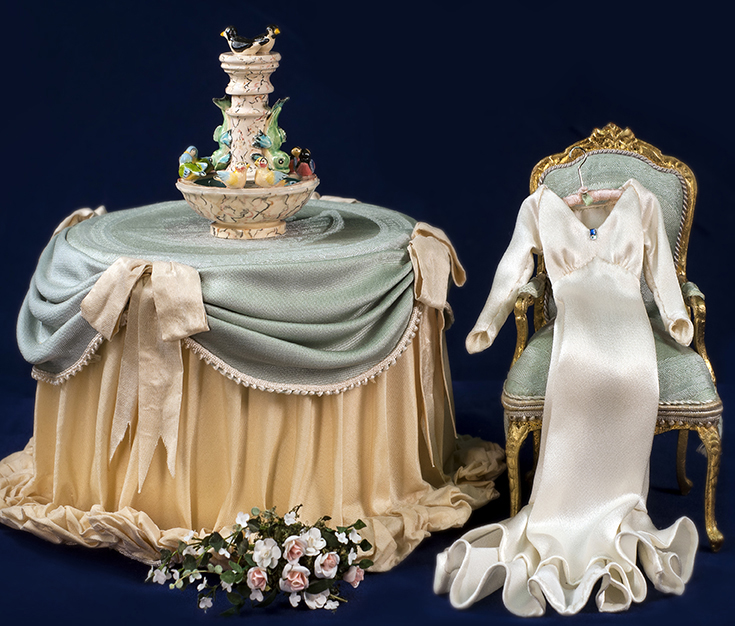
Janet Middlebrook Unveiled
 Every spring, when we put the wedding exhibit up as part of our seasonal displays, I have to pause in amazement at the work of Janet Middlebrook. Placing her tiny wedding dresses on hangers and fluffing a 1/12-scale bridal veil she created offers a beautiful reminder of her body of work, which spans over 35 years. Today, the California artist only takes museum commissions and sells at one show a year so I feel privileged to have her work in the collection.
Every spring, when we put the wedding exhibit up as part of our seasonal displays, I have to pause in amazement at the work of Janet Middlebrook. Placing her tiny wedding dresses on hangers and fluffing a 1/12-scale bridal veil she created offers a beautiful reminder of her body of work, which spans over 35 years. Today, the California artist only takes museum commissions and sells at one show a year so I feel privileged to have her work in the collection.
 Janet’s specialty is heirloom sewing of period-specific bridal wear and fashion. In fact, I’ve seen collectors create entire bridal shops around her miniature wedding gowns. When she began, she says most collectors were interested in Victorian styles, but over the years she’s found herself gravitating toward the fashions of the ’20s and ’30s because the materials, details, and techniques used during those times, she feels, are “unmatched,” often making or breaking the gowns. Think Jean Harlow, anything Gatsby, or Lady Mary’s pearl- and crystal-encrusted trousseau in Downton Abbey. These elegant column styles in sumptuous body-hugging fabrics which often include intricate beading and art-deco embellishments are favored by Janet for their artistry.
Janet’s specialty is heirloom sewing of period-specific bridal wear and fashion. In fact, I’ve seen collectors create entire bridal shops around her miniature wedding gowns. When she began, she says most collectors were interested in Victorian styles, but over the years she’s found herself gravitating toward the fashions of the ’20s and ’30s because the materials, details, and techniques used during those times, she feels, are “unmatched,” often making or breaking the gowns. Think Jean Harlow, anything Gatsby, or Lady Mary’s pearl- and crystal-encrusted trousseau in Downton Abbey. These elegant column styles in sumptuous body-hugging fabrics which often include intricate beading and art-deco embellishments are favored by Janet for their artistry.
Her inspiration for these creations comes from her library of more than 200 books, magazines, and catalogs on vintage costumes and fashion and from Turner Classic Movies (she loves Old Hollywood glamour), where she closely examines the movement of fabric. Once set on a design, she looks no further than to the collection of textiles she’s acquired over the years—most from the fabric district in London. She lists fine silks, satins, cashmere, batiste, tulle, and vintage lace (the majority from France and Italy) as her medium, in every shade of ivory, champagne, and white imaginable. And her studio sounds like a designer’s dream filled with rhinestones, crystals, sequins, beads, and terribly expensive trim, sashes, ribbons, fur, feathers, and 100% silk threads. Janet jokes that she needs a 12-step program for fabrics and I truly understand that.
 Those fabrics and the details were what first attracted me to her pieces when I began adding textiles to the collection. Period costumes, and their preciseness in both style and material, represent a beautiful, and often overlooked, element of history. They reflect economic and cultural influences, as well as the overall mood of the times. The pieces are striking when presented alone, but also add vibrancy and realism when dressing dolls used in room boxes and exhibits.
Those fabrics and the details were what first attracted me to her pieces when I began adding textiles to the collection. Period costumes, and their preciseness in both style and material, represent a beautiful, and often overlooked, element of history. They reflect economic and cultural influences, as well as the overall mood of the times. The pieces are striking when presented alone, but also add vibrancy and realism when dressing dolls used in room boxes and exhibits.
 In the gallery, Janet’s wedding gowns are displayed in an exhibit devoted solely to bridal wear and accoutrements. The exhibit always impresses visitors who are struck by the sheer time and patience it takes to sew the gowns and, I suspect, they are also reminded of special times in their own life. I, too, adore a wedding, but every year when we put together the bridal display, my mind goes not to the ceremony, the dress, and the flowers, but to Janet in her studio surrounded by yards of fine fabrics contemplating her artistic process that becomes these beautiful gowns.
In the gallery, Janet’s wedding gowns are displayed in an exhibit devoted solely to bridal wear and accoutrements. The exhibit always impresses visitors who are struck by the sheer time and patience it takes to sew the gowns and, I suspect, they are also reminded of special times in their own life. I, too, adore a wedding, but every year when we put together the bridal display, my mind goes not to the ceremony, the dress, and the flowers, but to Janet in her studio surrounded by yards of fine fabrics contemplating her artistic process that becomes these beautiful gowns.
